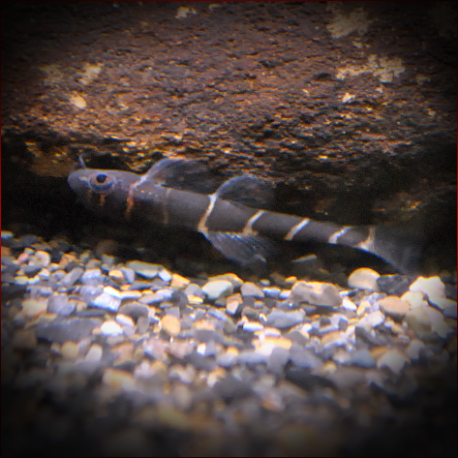More info
Datasheet
| Minimum Tank Size | 60 litres / 15.85 US gallons |
| Maximum Size | 5.0cm / 1.97inches |
| Temperature | 20°C / 68.00°F - 25°C / 77.00°F |
| Hardness | 1.01dgH / 18ppm - 10.03dgH / 179ppm |
| pH | 5.5-7.5 |
General Description
Barbucca spp. are infrequent in the aquarium trade, with only B. diabolica officially recognized. These fish exhibit unique features such as red eyes, tuberculation, and dark body stripes. They have a distinctive swimming style, often maintaining belly contact with solid surfaces and swimming inverted or vertically. Their phylogenetic position was clarified in 2007, grouping them with balitorids. The erecting of the Barbuccidae family was necessary to accommodate their morphological peculiarities, including distinct mouth and swim bladder structures.
Aquarium Setup
For optimal display, Barbucca diabolica should be kept in a tank with sand/gravel substrate, plenty of water worn rocks for hiding places, driftwood, and aquatic plants like Microsorum pteropus and Anubias spp. Bright lighting aids in aufwuchs growth, a preferred food source. Leaf litter can be added for a natural look. Clean water is essential for their well-being, requiring mature and stable aquarium conditions. Weekly water changes of 30-50% tank volume are recommended.
Behaviour
Barbucca diabolica is not aggressive but rather protective of its foraging area, engaging in short chasing attacks. They are compatible with smaller schooling fish and freshwater shrimp but should not be housed with larger or competitive species. These loaches thrive in the presence of conspecifics and group sizes of six to eight are ideal for their well-being.
Feeding and Diet
While little is known about their natural diet, in captivity, Barbucca diabolica accepts dried foods, live, or frozen offerings like Artemia nauplii and Cyclops. Food provided should be of small grade to ensure consumption.
Reproduction & Dimorphism
There are no existing records of the reproduction of Barbucca diabolica. Sexual dimorphism includes both sexes possessing tubercles, with mature males displaying additional tuberculation around the base and rear of the eye.
Habitat and Distribution
Found mainly in small forest streams in Borneo and possibly in Thailand and Sumatra, these fish prefer areas with ample hiding spots like rocks, boulders, and driftwood. They are not typically found in open water but inhabit marginal zones where they can forage for food. The poorly studied Malaysian populations may represent separate species in the future.

